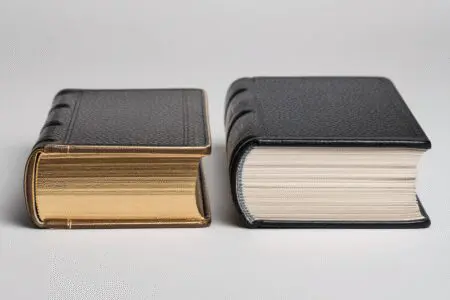Have you ever walked into a Christian bookstore, headed for the Bible section, and just stopped dead in your tracks? The sheer number of options is overwhelming. You’ve got leather-bound, paperback, study Bibles, devotional Bibles, Bibles for men, Bibles for women, Bibles for teens. And the names—NIV, ESV, KJV, NLT, NASB, The Message—it feels like you need a secret decoder ring just to figure out what you’re looking at.
I’ve been there. My first “real” Bible was one my grandma gave me, a classic King James Version with a stiff black cover. I tried so hard to read it, but I felt like I was trying to decipher a foreign language. The journey to figure out What Is the Best Translation of the Bible felt like a quest without a map.
Here’s the honest truth I’ve learned after more than a decade of serious study, leading small groups, and wrestling with the text myself: the “best” Bible translation is the one you will actually read, understand, and apply to your life. But that’s not the whole story. Your choice deeply impacts how you connect with God’s Word. This guide is the conversation I wish someone had with me all those years ago—no confusing jargon, just straight talk from one believer to another.
More in Bible Category
What Is the Best Cross Reference Bible
Key Takeaways
For those who just want the quick answer, here’s the rundown:
- There is no single “best” translation. The right choice depends entirely on your goal: deep study, daily reading, or a fresh devotional perspective.
- Translations fall on a spectrum. They range from “word-for-word” (literal) to “thought-for-thought” (dynamic). Understanding this spectrum is the key to choosing wisely.
- For deep, scholarly study, the ESV or NASB are fantastic choices due to their literal accuracy.
- For everyday reading and church use, the NIV strikes a wonderful, readable balance between accuracy and clarity. It’s the most popular for a reason.
- For new believers or devotional reading, the NLT communicates the heart of the message in warm, easy-to-understand language.
- The goal is connection, not perfection. Don’t get paralyzed by the options. The most important step is to simply open the book and start reading.
Why Can’t We Just Have One Bible Translation?
It’s a fair question. Wouldn’t it be simpler if there was just one official “The Bible”? Absolutely. But the reality is a bit more complex, and frankly, it’s a beautiful thing. The Bible wasn’t originally written in English. The Old Testament was primarily written in Hebrew, with a few bits in Aramaic, and the New Testament was written in Koine Greek.
Translating any text from an ancient language into modern English is a massive undertaking. It’s more art than science. You’re not just swapping out words; you’re trying to carry over culture, poetry, idioms, and profound theological concepts across thousands of years.
Think about it. If someone says, “It’s raining cats and dogs,” you know exactly what they mean. But a literal, word-for-word translation into another language would be nonsense. Bible translators face this kind of challenge in nearly every verse. Furthermore, we are constantly making new archaeological discoveries, like the Dead Sea Scrolls, which give scholars an even clearer picture of the original manuscripts. Each new translation benefits from the latest scholarship, aiming to bring us closer to the original intent of the authors.
The Crucial Difference: Are You Reading the Exact Words or the Core Message?
This is the single most important concept to grasp. Nearly all translations can be placed on a spectrum. On one end, you have “formal equivalence,” and on the other, “dynamic equivalence.”
That sounds complicated, I know. Let’s just call them “word-for-word” and “thought-for-thought.”
What is a “Word-for-Word” (Formal Equivalence) Translation?
These translations try to stick as closely as possible to the sentence structure and word order of the original Hebrew and Greek. The goal is transparency—to give you a window into how the original text was constructed.
- Pros: They are incredible for deep, serious study. If you want to see the repetition of a specific word or understand the grammar, this is your go-to.
- Cons: Let’s be honest, they can be clunky. The English can sound unnatural and sometimes be hard to understand because it’s preserving a foreign sentence structure.
Examples include the King James Version (KJV), New American Standard Bible (NASB), and the English Standard Version (ESV).
What is a “Thought-for-Thought” (Dynamic Equivalence) Translation?
These translations focus on conveying the meaning of the original text. The translators ask, “What was the author trying to say, and how can we best express that same thought in natural, modern English?” They are less concerned with keeping the exact word order and more concerned with the overall message.
- Pros: They are almost always much easier to read and understand. The language flows smoothly, making it great for daily reading or for someone new to the Bible.
- Cons: You are trusting the translation committee’s interpretation of the original thought a bit more. It’s one step removed from the literal words.
Examples include the New International Version (NIV) and the New Living Translation (NLT).
And What About Paraphrases?
On the far end of the “thought-for-thought” side, you have paraphrases. These are not strict translations. Instead, they are a restatement of the message in a highly contemporary voice. They are fantastic for breathing new life into familiar passages but aren’t suitable for establishing doctrine or deep study. The best-known example is The Message (MSG).
My Personal Rankings and Breakdown of the Most Popular Bible Translations
Alright, let’s get down to the nitty-gritty. I’m going to walk you through the most popular translations, tell you where they land on the spectrum, and share some of my own experiences with them.
For the Lover of Classic Literature: The King James Version (KJV)
This is the grandfather of English Bibles. For centuries, it was the Bible for the English-speaking world.
- Spectrum: Word-for-Word.
- Who It’s For: Anyone who appreciates majestic, poetic language and isn’t afraid of a challenge. It’s for the traditionalist who grew up with its beautiful cadence.
- My Take: The KJV is undeniably beautiful. Its language has shaped the English language itself. However, it can be a major stumbling block for modern readers. The “thees,” “thous,” and archaic words (what’s a “wimples” or “sackbut”?) make it very difficult to understand without a dictionary. When I first tried to read it, I felt more confused than inspired. I have deep respect for the KJV, but I rarely recommend it for a primary reading Bible today.
For the Meticulous Student: The New American Standard Bible (NASB)
Often called one of the most literal English translations ever produced. If you want to know what the Greek or Hebrew says, the NASB is about as close as you can get in English.
- Spectrum: Heavily Word-for-Word.
- Who It’s For: Pastors, seminary students, and anyone doing serious, in-depth word studies.
- My Take: I pull out my NASB when I’m studying a passage for a small group and a specific word seems critical. I want to know the most direct rendering. However, I find it very wooden for general reading. It prioritizes technical accuracy over readability, which is a noble goal, but it doesn’t always stir the heart. It’s a fantastic tool for the workshop, but maybe not the best for relaxing by the fire.
For the Modern Scholar: The English Standard Version (ESV)
The ESV has exploded in popularity over the last two decades, especially in more conservative and reformed circles. It’s a revision of the older Revised Standard Version (RSV) and takes a very word-for-word approach.
- Spectrum: Word-for-Word.
- Who It’s For: Serious readers who want a literal translation in modern English. It’s a great choice for study, preaching, and memorization.
- My Take: This has become my primary study Bible. The ESV is precise, but the language is more elegant and readable than the NASB. It retains a touch of classic, literary feel without the archaic words of the KJV. When I’m preparing a lesson, the ESV is open on my desk. It’s a translation that trusts the reader to do the work, and I appreciate that.
For the Everyday Believer: The New International Version (NIV)
For decades, the NIV has been the bestselling Bible translation, and for good reason. It was created by a massive team of scholars with the specific goal of balancing accuracy and readability.
- Spectrum: Right in the middle. A perfect blend of Word-for-Word and Thought-for-Thought.
- Who It’s For: Honestly, just about everyone. It’s an outstanding choice for a first Bible, for daily reading, for church services, and for small groups.
- My Take: The NIV was my “daily driver” for years. It’s the translation I first fell in love with Scripture in. It’s clear, reliable, and easy to understand. While some scholars might argue it smooths over certain rough edges of the Greek, I find it does an incredible job of communicating the core message faithfully. You simply cannot go wrong starting with the NIV.
For a Fresh Touch of the Heart: The New Living Translation (NLT)
The NLT is a beautiful and moving translation that focuses on communicating the warmth and heart of the message. It began as a revision of a paraphrase (The Living Bible) but became a full-blown translation.
- Spectrum: Thought-for-Thought.
- Who It’s For: New believers, teens, and anyone who wants a highly readable, heartwarming devotional experience.
- My Take: I have a soft spot for the NLT. There are times when a familiar passage in the ESV or NIV just doesn’t hit me emotionally. I’ll turn to the same verses in the NLT, and the clear, relational language can bring tears to my eyes. Reading the Psalms in the NLT feels less like reading ancient poetry and more like reading a friend’s diary. It’s a wonderful companion Bible.
For a Jolt of Contemporary Language: The Message (MSG)
The Message is not a translation; it’s a paraphrase by the late pastor Eugene Peterson. He wanted to bring the vitality and freshness of the original Greek into the language of the people he talked to every day.
- Spectrum: Paraphrase.
- Who It’s For: Longtime Christians who feel stuck in a rut with the Bible, or anyone curious about a completely different take on the text.
- My Take: The Message is a lightning rod. Some people love it; some people hate it. I land somewhere in the middle. I would never use it to build a theological argument. But sometimes, when I’m stumped by a passage in Paul’s letters, Peterson’s energetic, conversational rendering helps me see the big picture. It’s like listening to a passionate sermon from a wise old friend. Use it as a commentary, not as your primary Bible.
So, How Do You Pick Your Bible?
Okay, that’s a lot of information. How do you actually make a choice? It’s not as hard as it seems. Let me offer a few practical steps that have helped me and many others.
Ask Yourself These Three Questions
- What is my main purpose? If you’re planning on intense, line-by-line study, lean toward the “word-for-word” side (ESV, NASB). If your goal is to read a chapter or two each day for encouragement and growth, the “thought-for-thought” side is your friend (NIV, NLT).
- What is my reading style? Do you enjoy classic literature and poetry (KJV)? Or do you prefer clear, modern, direct prose (NIV, NLT)? Be honest with yourself. There are no extra points for choosing a Bible that’s harder for you to read.
- Who am I reading with? If your church uses the ESV in the pulpit or your small group studies from the NIV, it can be very helpful to use the same translation. It just makes following along that much easier.
My Tried-and-True Method: The ‘Trio’ Approach
I often encourage people to eventually build a small library—a trio of Bibles for different purposes. This has been the most fruitful approach in my own life.
- One for STUDY: A solid, literal, word-for-word translation like the ESV. This is your reference book.
- One for READING: A balanced, thought-for-thought translation like the NIV or NLT. This is your daily companion.
- One for PERSPECTIVE: A paraphrase like The Message. This is what you pick up when you want to see things in a new light.
Is My Bible Translation ‘Wrong’ or ‘Less Inspired’?
This is a question that carries a lot of fear. Some groups insist that only one translation is God’s true Word for English speakers. Let me put your mind at ease. I’ve spent a lot of time digging into the translation process on seminary websites and in books to better understand this. Reputable modern translations (like all the ones listed above) are completed by large committees of brilliant, god-fearing scholars from various denominations. They prayerfully and painstakingly work from the best available manuscripts to faithfully render the text in English.
One resource I found incredibly helpful comes from Dallas Theological Seminary, which has a fantastic breakdown of the complexities of this work. Their scholars emphasize that while translations have different philosophies, the core message of the gospel—the life, death, and resurrection of Jesus Christ—is perfectly clear in all of them.
The differences between major translations are almost always about the choice of English words, not about fundamental changes to theology.
The Best Bible is the One You’ll Actually Read
We’ve covered a lot of ground. We’ve talked about translation theories, the pros and cons of different versions, and how to choose one. But I want to bring it all back to where we started.
Don’t let the search for the “perfect” Bible keep you from the God of the Bible. The goal is not to win a debate; the goal is to have your life transformed by the living Word of God. The most doctrinally precise, literally accurate translation in the world is useless if it just sits on your shelf collecting dust.
Find a translation that speaks to you. Find one that makes you want to turn the page. The real journey begins when you open its cover, quiet your heart, and ask God to speak. I promise you, He will.
Frequently Asked Questions – What Is the Best Translation of the Bible

How should I choose the right Bible translation for myself?
To choose the right translation, think about your purpose, compare different versions by reading a familiar passage, and pray for guidance. This process helps you find the Bible that will be most meaningful and accessible for you.
What Bible translation is recommended for daily devotional reading?
The New International Version (NIV) is highly recommended for daily reading because it is easy to understand and expresses God’s word in warm, clear language. The Christian Standard Bible (CSB) is also a good balanced choice for everyday use.
Which translation is best for deep study of the Bible?
For deep study, a word-for-word translation like the New American Standard Bible (NASB) or the English Standard Version (ESV) is best because they stay close to the original wording and grammar.
What is the difference between word-for-word and thought-for-thought translations?
Word-for-word translations, also called formal equivalence, aim to match the exact words and grammar of the original texts, making them good for detailed study but harder to read. Thought-for-thought translations, or dynamic equivalence, focus on conveying the main idea in simple, modern language, making them easier to understand for daily reading.
Why are there so many different translations of the Bible?
There are many Bible translations because the original texts were written in Hebrew, Aramaic, and Greek, which do not match English perfectly. Additionally, English has changed over time, and different translations aim for different goals, such as accuracy or readability.




